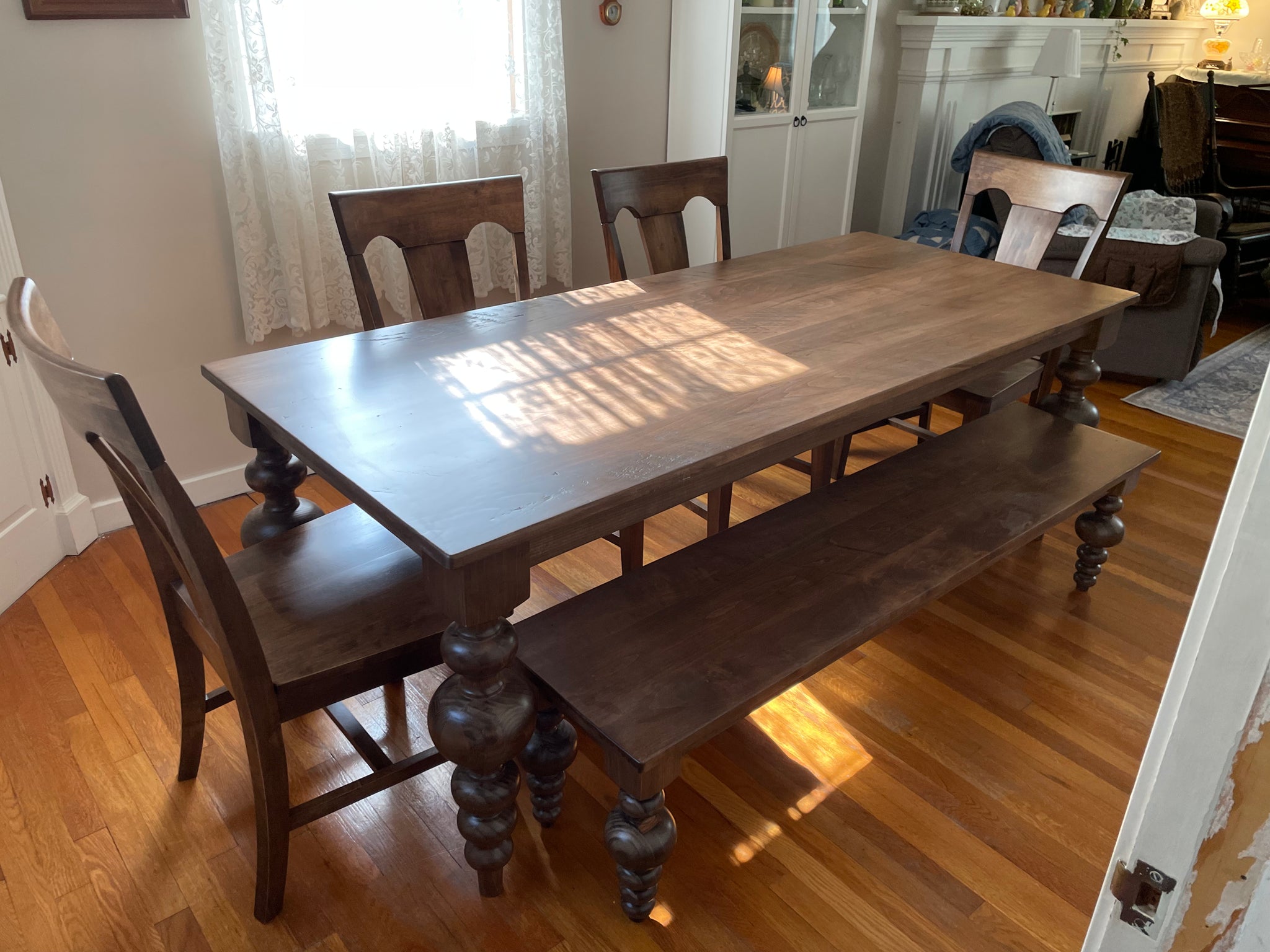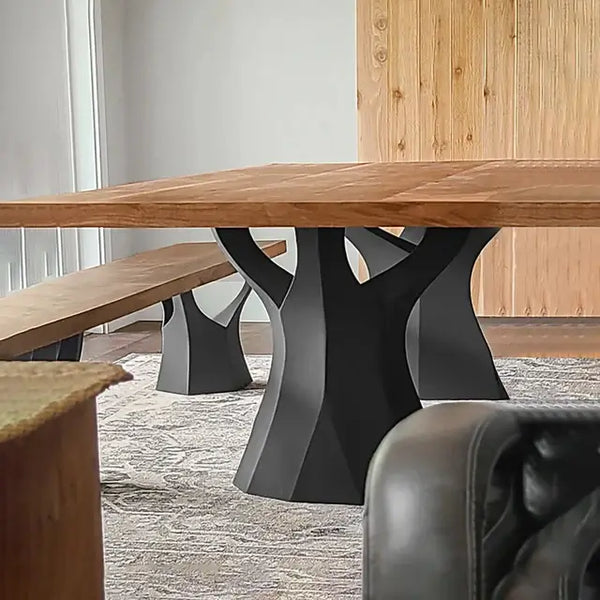Unique Dining Room Table Legs That Will Elevate Your Dining Area
From Standard to Modern: Discover the Suitable Dining Area Table Legs for Your Design
The choice of dining-room table legs plays an essential role in specifying the total personality of your space, bridging the void in between traditional workmanship and contemporary appearances. While classic styles such as cabriole and transformed legs evoke a feeling of classic elegance, modern designs like hairpin and geometric alternatives offer a possibility for striking aesthetic interest. Reviewing the appropriate equilibrium between these designs requires a nuanced understanding of your existing design and personal preference. As you consider these aspects, the inquiry continues to be: just how can you effortlessly integrate these varied leg designs to create an unified dining experience?
Understanding Table Leg Styles
The variety of dining-room table leg styles can substantially influence both the aesthetics and capability of the space. Each leg design adds one-of-a-kind visual elements and functional attributes, catering to diverse design choices and use requirements. Understanding these designs is critical for picking the appropriate table that lines up with your general interior design vision.
As an example, conical legs offer a tidy, traditional appearance that can boost a room's elegance, while stand bases supply stability and maximize legroom, making them perfect for smaller spaces. Barrette legs, a trademark of mid-century modern-day style, introduce an industrial panache, enabling an airy, open feeling. Similarly, trestle legs stimulate rustic charm, providing robust assistance and a feeling of timelessness.
Wood legs can bring heat and appearance, whereas metal choices typically share a sleek, modern ambiance. Eventually, understanding table leg designs is necessary for developing a cohesive eating area that mirrors personal design while ensuring usefulness and convenience.
Traditional Table Leg Options
When choosing eating room table legs, typical choices usually symbolize ageless sophistication and workmanship. These layouts show a rich heritage and a commitment to high quality, making them optimal for those that appreciate timeless aesthetic appeals.
Among one of the most legendary traditional leg designs is the cabriole leg, defined by its stylish curved form. This layout typically features decorative carvings and is most typically found in Queen Anne and Chippendale furniture. Another popular alternative is the turned leg, which boasts a collection of smooth, rounded shapes that offer a timeless look while keeping security.
Furthermore, the straight leg, while easy, uses a basic and strong framework that can blend effortlessly with a selection of tabletop designs. For those attracted to ornate outlining, claw-and-ball feet legs evoke a sense of grandeur and can act as a sensational focal point in any kind of dining space.
Finally, stand bases, although not strictly legs, offer a different typical option that enables for sufficient legroom and can be beautifully sculpted. Each of these standard leg styles adds to the general ambiance of a dining-room, weding function with aesthetic appeal.

Modern Table Leg Designs
Modern table leg styles provide a diverse variety of styles that emphasize ingenious materials and tidy lines. These layouts usually prioritize performance while offering as striking see prime focus within an eating room. Minimalist aesthetic appeals prevail, with legs crafted from materials such as metal, glass, and crafted timber, which add to a airy and modern feel.
One preferred design is the hairpin leg, characterized by its slender, tapered framework that gives security without overwhelming the table top (dining room visit this web-site table legs). This style is frequently located in mid-century contemporary furniture and can easily enhance various eating table forms. An additional pattern is the usage of geometric forms, where legs might tackle angular or unbalanced kinds, including aesthetic passion and a touch of artistry

Mixing Designs for One-of-a-kind Spaces
Frequently, house owners look for to create special dining spaces that reflect their individual style by mixing various layout components. This technique permits the consolidation of varied appearances, leading to a harmonious yet distinct environment. Coupling a rustic wooden table with streamlined, contemporary steel legs can create a captivating contrast that boosts the area's general appeal.
In addition, incorporating vintage table legs with modern table tops can stimulate a sense of background while maintaining a contemporary perceptiveness. Such mixes not only showcase specific taste however also encourage creative thinking, allowing house owners to curate a space that feels both personal and inviting.
Shade plays a vital role in this mixing procedure; selecting table legs that match or contrast with the existing color system can improve visual interest. Whitewashed legs can soften the boldness of a dark table surface, creating a balanced visual.
Tips for Picking the Right Legs
Choosing the right table legs is crucial for attaining both capability and visual appeal in your dining space. Begin by considering the general design of your area. Traditional settings take advantage of legs that feature complex carvings or transformed designs, while contemporary spaces may require streamlined, minimalist styles.
Next, examine the elevation and stability of the legs. dining room table legs. Basic eating tables range between 28 to 30 inches in height, so ensure the legs enhance this measurement for comfort. Furthermore, robust materials, her latest blog such as hardwood or steel, can improve stability and durability
Assess the leg shape also-- options include directly, tapered, or stand designs. Straight legs offer a classic appearance, while conical legs can include a touch of style. Pedestal bases provide ample legroom and are perfect for smaller spaces.
Final Thought
In recap, picking the perfect eating space table legs needs careful factor to consider of both standard and contemporary designs. By integrating leg design, elevation, and product with the total design, a cohesive and welcoming environment can be achieved.
The range of dining space table leg styles can significantly affect both the appearances and capability of the space. Inevitably, recognizing table leg designs is essential for developing a cohesive eating area that shows individual design while ensuring usefulness and comfort.One of the most iconic traditional leg styles is the cabriole leg, identified by its stylish rounded form. Straight legs provide a timeless look, while tapered legs can include a touch of style.In recap, selecting the ideal dining room table legs requires mindful factor to consider of both traditional and modern-day designs.